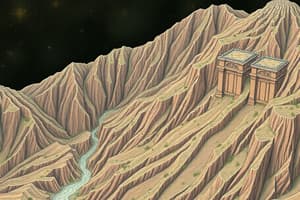Podcast
Questions and Answers
What primarily causes mass wasting in mountainous areas?
What primarily causes mass wasting in mountainous areas?
- Excessive vegetation cover
- Low levels of soil moisture
- Stable weather patterns
- Increased slope steepness (correct)
What is a characteristic of slumps in mass wasting?
What is a characteristic of slumps in mass wasting?
- They occur on flat surfaces only.
- They involve the rapid flow of water and debris.
- They involve coherent rock materials sliding along a curved surface. (correct)
- They are triggered exclusively by volcanic activity.
How does excessive rainfall affect the stability of a mountain slope?
How does excessive rainfall affect the stability of a mountain slope?
- It causes soil particles to break apart and lose cohesion. (correct)
- It makes the vegetation thrive.
- It strengthens the bond between soil particles.
- It has no significant impact.
Which of the following is NOT a cause of mass wasting?
Which of the following is NOT a cause of mass wasting?
What happens to a mountain slope that has reduced vegetation cover?
What happens to a mountain slope that has reduced vegetation cover?
What is the nature of the movement in mass wasting events?
What is the nature of the movement in mass wasting events?
What would likely occur if a mountain slope experiences an earthquake?
What would likely occur if a mountain slope experiences an earthquake?
Which statement about the relationship between mass wasting and water is accurate?
Which statement about the relationship between mass wasting and water is accurate?
What characterizes a slump in mass wasting events?
What characterizes a slump in mass wasting events?
How does a rockslide differ from a slump?
How does a rockslide differ from a slump?
What is a primary characteristic of a debris flow?
What is a primary characteristic of a debris flow?
What best describes the movement of an earthflow?
What best describes the movement of an earthflow?
Which of the following human activities can contribute to slumps?
Which of the following human activities can contribute to slumps?
What is an important component of debris flow that contributes to its destructive nature?
What is an important component of debris flow that contributes to its destructive nature?
What type of material is predominantly found in an earthflow?
What type of material is predominantly found in an earthflow?
Flashcards
Mass Wasting
Mass Wasting
The large movement of rock, soil, and debris downward due to gravity.
Causes of Mass Wasting
Causes of Mass Wasting
Factors that make a slope more likely to slide, like steep slopes, too much water, and lack of vegetation.
Slope Steepness
Slope Steepness
A steeper slope makes it easier for gravity to pull materials down the mountain.
Water's Role in Mass Wasting
Water's Role in Mass Wasting
Signup and view all the flashcards
Vegetation's Role in Mass Wasting
Vegetation's Role in Mass Wasting
Signup and view all the flashcards
Slump
Slump
Signup and view all the flashcards
Earthquake's effect on mass wasting
Earthquake's effect on mass wasting
Signup and view all the flashcards
Resisting force
Resisting force
Signup and view all the flashcards
Slump (Mass Wasting)
Slump (Mass Wasting)
Signup and view all the flashcards
Rockslide (Mass Wasting)
Rockslide (Mass Wasting)
Signup and view all the flashcards
Debris Flow (Mass Wasting)
Debris Flow (Mass Wasting)
Signup and view all the flashcards
Earthflow (Mass Wasting)
Earthflow (Mass Wasting)
Signup and view all the flashcards
Rotational Slide
Rotational Slide
Signup and view all the flashcards
Translational Slide
Translational Slide
Signup and view all the flashcards
Study Notes
Mass Wasting Overview
- Mass wasting is the downward movement of rock, soil, and debris due to gravity.
- Various factors contribute to mass wasting, including steep slopes, excessive water, and vegetation loss.
- Natural forces and human activities can trigger mass wasting events.
Types of Mass Wasting
Slumps
- Slumps involve the sliding of coherent rock materials along a curved surface.
- It’s a rotational slide where a section of the slope rotates around an axis.
- Slumps can occur as single units or in groups and form due to erosion at the base of the slope (e.g., by water or waves).
- Human activities, such as road construction, can also trigger slumps.
Rockslides
- Rockslides are the sliding of rock material along a pre-existing plane.
- Unlike slumps, rockslides move in a more uniform direction.
- They often result in piles of rock at the base of a slope.
Debris Flows
- Debris flows are the movement of water-laden loose material (mud, sand, soil, rock, debris) down a slope.
- They can reach high speeds, up to over 100 miles per hour.
- These flows often carry debris, including trees, bridges, and buildings, posing significant danger.
Earthflows
- Earthflows involve the flow of fine-grained material (clay, silt, pyroclastic material) that combine with moisture.
- The speed varies significantly, from extremely slow (inches per year) to moderate speeds.
- Earthflows often form a distinctive hourglass shape.
- Typically develop at the lower end of a slope or at the base of slumps.
Studying That Suits You
Use AI to generate personalized quizzes and flashcards to suit your learning preferences.




